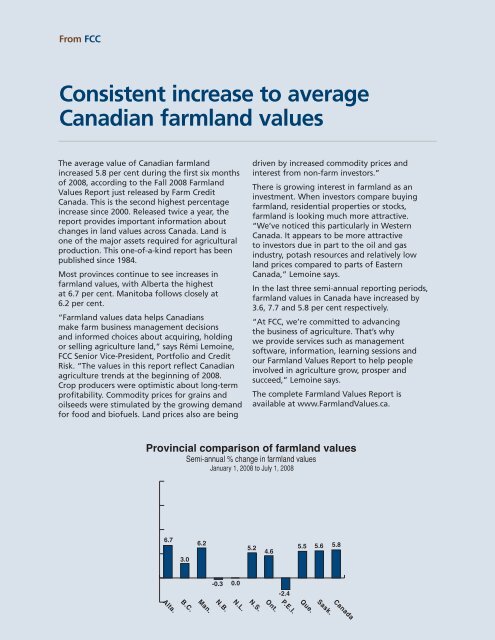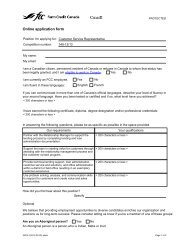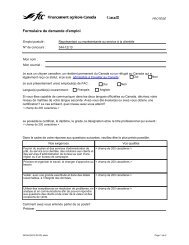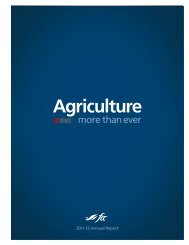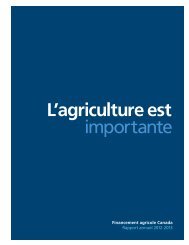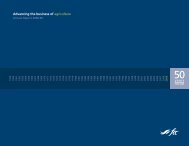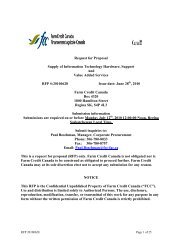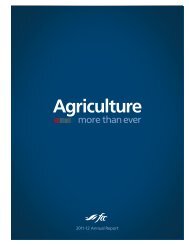Read the full version (PDF) - FCC-FAC
Read the full version (PDF) - FCC-FAC
Read the full version (PDF) - FCC-FAC
Create successful ePaper yourself
Turn your PDF publications into a flip-book with our unique Google optimized e-Paper software.
From <strong>FCC</strong><br />
Consistent increase to average<br />
Canadian farmland values<br />
The average value of Canadian farmland<br />
increased 5.8 per cent during <strong>the</strong> first six months<br />
of 2008, according to <strong>the</strong> Fall 2008 Farmland<br />
Values Report just released by Farm Credit<br />
Canada. This is <strong>the</strong> second highest percentage<br />
increase since 2000. Released twice a year, <strong>the</strong><br />
report provides important information about<br />
changes in land values across Canada. Land is<br />
one of <strong>the</strong> major assets required for agricultural<br />
production. This one-of-a-kind report has been<br />
published since 1984.<br />
Most provinces continue to see increases in<br />
farmland values, with Alberta <strong>the</strong> highest<br />
at 6.7 per cent. Manitoba follows closely at<br />
6.2 per cent.<br />
“Farmland values data helps Canadians<br />
make farm business management decisions<br />
and informed choices about acquiring, holding<br />
or selling agriculture land,” says Rémi Lemoine,<br />
<strong>FCC</strong> Senior Vice-President, Portfolio and Credit<br />
Risk. “The values in this report reflect Canadian<br />
agriculture trends at <strong>the</strong> beginning of 2008.<br />
Crop producers were optimistic about long-term<br />
profitability. Commodity prices for grains and<br />
oilseeds were stimulated by <strong>the</strong> growing demand<br />
for food and biofuels. Land prices also are being<br />
driven by increased commodity prices and<br />
interest from non-farm investors.”<br />
There is growing interest in farmland as an<br />
investment. When investors compare buying<br />
farmland, residential properties or stocks,<br />
farmland is looking much more attractive.<br />
“We’ve noticed this particularly in Western<br />
Canada. It appears to be more attractive<br />
to investors due in part to <strong>the</strong> oil and gas<br />
industry, potash resources and relatively low<br />
land prices compared to parts of Eastern<br />
Canada,” Lemoine says.<br />
In <strong>the</strong> last three semi-annual reporting periods,<br />
farmland values in Canada have increased by<br />
3.6, 7.7 and 5.8 per cent respectively.<br />
“At <strong>FCC</strong>, we’re committed to advancing<br />
<strong>the</strong> business of agriculture. That’s why<br />
we provide services such as management<br />
software, information, learning sessions and<br />
our Farmland Values Report to help people<br />
involved in agriculture grow, prosper and<br />
succeed,” Lemoine says.<br />
The complete Farmland Values Report is<br />
available at www.FarmlandValues.ca.<br />
Provincial comparison of farmland values<br />
Semi-annual % change in farmland values<br />
January 1, 2008 to July 1, 2008<br />
Canada<br />
Sask.<br />
Que.<br />
P.E.I.<br />
Ont.<br />
N.S.<br />
N.L.<br />
N.B.<br />
Man.<br />
B.C.<br />
Alta.<br />
6.7<br />
3.0<br />
6.2<br />
-0.3<br />
0.0<br />
5.2<br />
4.6<br />
-2.4<br />
5.5<br />
5.6<br />
5.8


